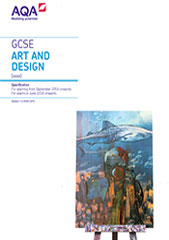3.2 Skills
Students develop and apply the skills listed below to realise personal intentions relevant to their chosen title(s) and related area(s) of study.
Students must demonstrate the ability to:
- develop their ideas through investigations informed by selecting and critically analysing sources
- apply an understanding of relevant practices in the creative and cultural industries to their work
- refine their ideas as work progresses through experimenting with media, materials, techniques and processes
- record their ideas, observations, insights and independent judgements, visually and through written annotation, using appropriate specialist vocabulary, as work progresses
- use visual language critically as appropriate to their own creative intentions and chosen
area(s) of study through effective and safe use of:
- media
- materials
- techniques
- processes
- technologies
- use drawing skills for different needs and purposes, appropriate to context
- realise personal intentions through sustained application of the creative process.
Drawing
Students must provide evidence of drawing in both their portfolio submission and externally set assignment. These can take different forms depending on intention. It can feature as an element within the developmental process and/or explicitly in the realisation of intentions. Drawing could be demonstrated in students’ evidence for AO1, AO2 and AO4, but must feature in their evidence for AO3. The particular value and significance of drawing should be determined by the ways in which it addresses purpose and need rather than the extent to which it demonstrates technical mastery, unless this is the explicit intention.
To ensure evidence of drawing features appropriately:
- access the online Drawing for different purposes and needs exemplar materials which include focused guidance on how drawing might feature in each title
- review examples of drawing within the context of students’ overall submissions (provided on e-AQA)
- ensure the person responsible for internal standardisation attends a teacher standardisation meeting to see 'live' examples of how students have met this requirement (in line with the requirements set out in Teacher Standardisation).
Written annotation
When addressing the requirements of AO3, students must record their ideas, observations and insights both visually and through written annotation using appropriate specialist vocabulary, as work progresses. Annotation must be explicitly evidenced in both Component 1 and Component 2.
The content and presentation of annotation will be determined by what the student wishes to communicate, including how it supports the development of their work through the creative process.
For example, as ideas are developed, explored and recorded annotations might relate to initial thoughts, practical considerations, the communication of intentions, responses to sources, critical reflection on personal work and self-evaluation. Teachers should encourage students to appreciate the purposes of annotation and understand where and how annotations can feature as an integral rather than ‘bolt-on’ aspect of the creative process. As such, annotation can also contribute to evidence for AO1, AO2 and AO4. Annotations can be presented in hand written and/or digital form as appropriate.
To ensure evidence of written annotation features appropriately:
- access the online exemplar materials and specific guidance on how written annotation might feature in each title
- review examples of students’ annotations within the context of students’ overall submissions (provided on e-AQA)
- ensure the person responsible for internal standardisation attends a teacher standardisation meeting to see 'live' examples of how students have met this requirement (in line with the requirements set out in Teacher Standardisation).
